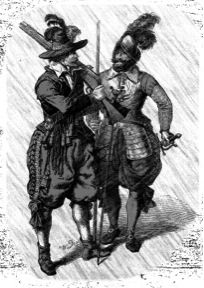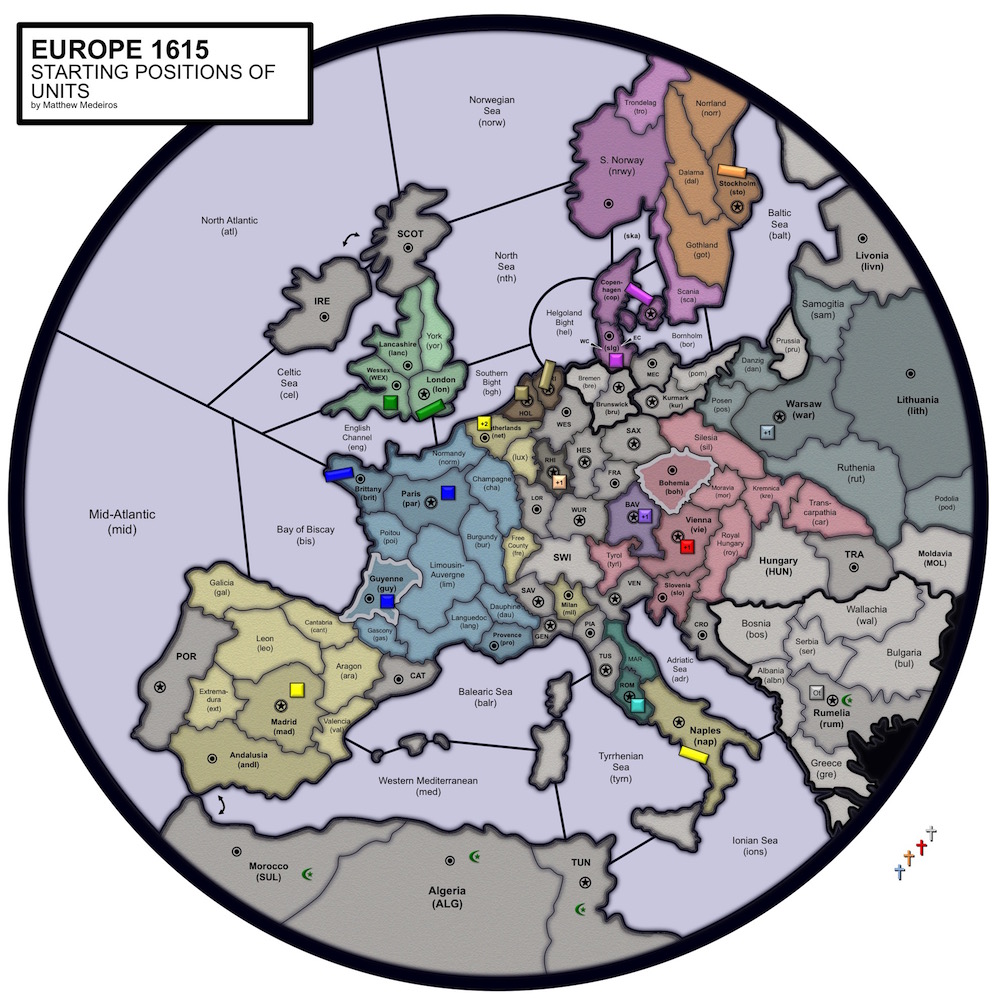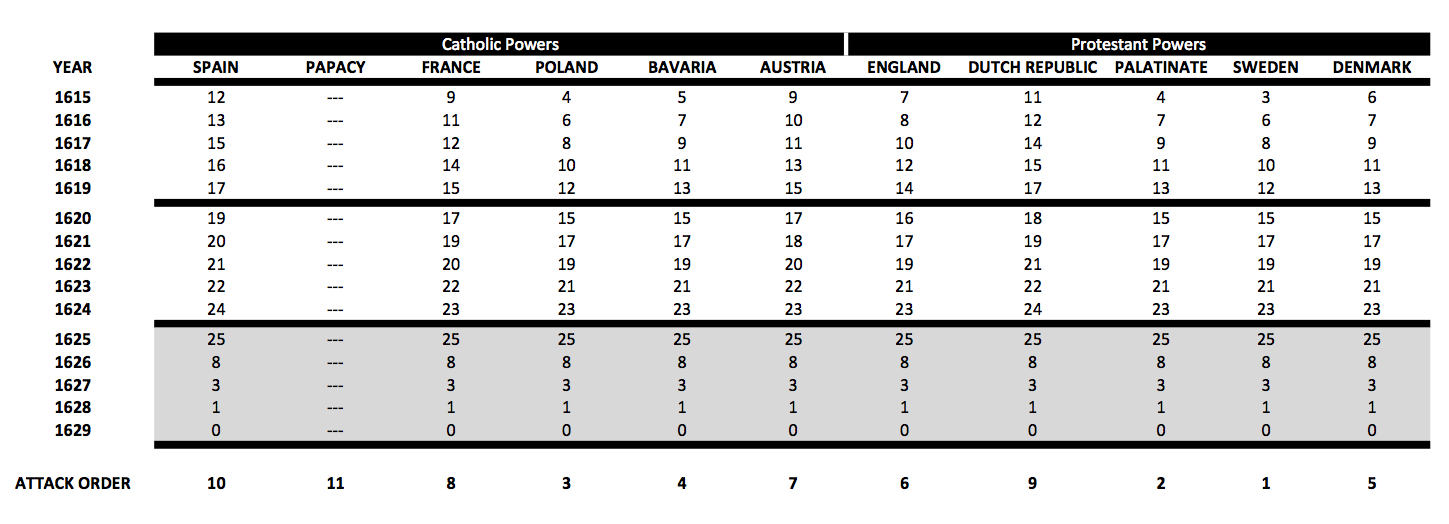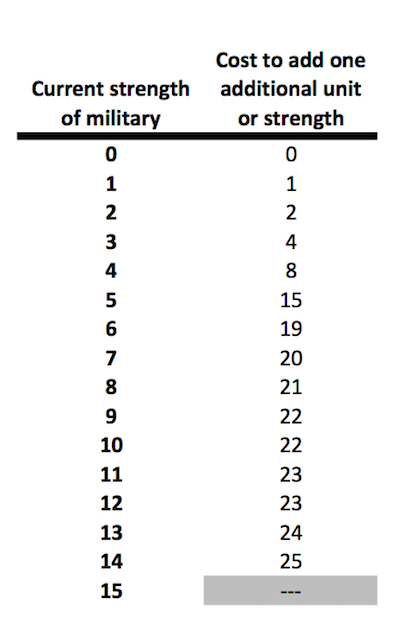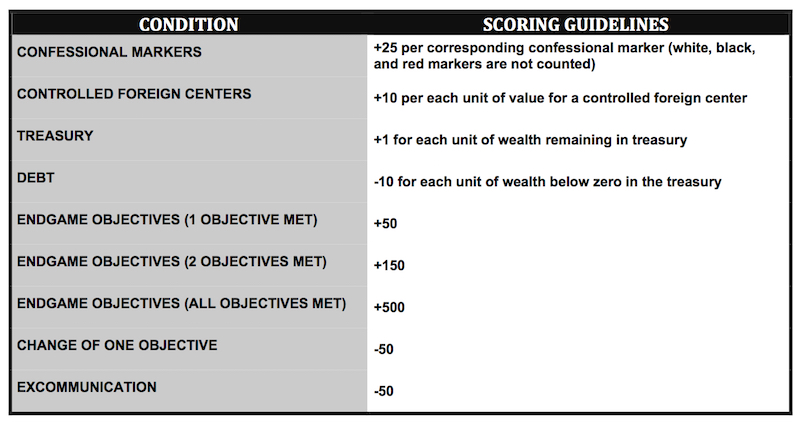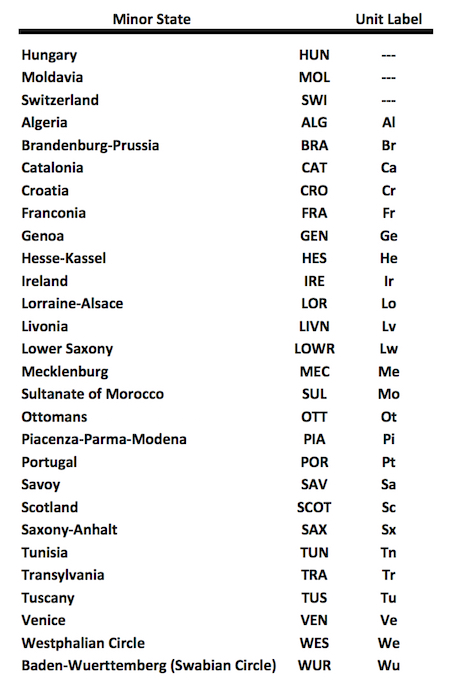Difference between revisions of "Europe 1615: Prelude to War"
| Line 71: | Line 71: | ||
Unaligned states are passable during a Movement and Retreat Phase, and may be occupied. | Unaligned states are passable during a Movement and Retreat Phase, and may be occupied. | ||
| − | =ALIGNED= | + | ===ALIGNED=== |
If a power holds minimally 50% of all INFs placed in the minor state, then the minor state is considered aligned to the power, and passable or impassable depending on the declarations that have been made. The minor state will then follow any order submitted to the state’s unit by the power it is aligned to. Only an aligned minor state can build and maintain units (see also NEUTRALITY). If a minor state becomes unaligned during a Movement and Retreat phase, all of its units disband at the Adjustment phase. This also means that if the state holds foreign centers, then its control of those states will be relinquished. | If a power holds minimally 50% of all INFs placed in the minor state, then the minor state is considered aligned to the power, and passable or impassable depending on the declarations that have been made. The minor state will then follow any order submitted to the state’s unit by the power it is aligned to. Only an aligned minor state can build and maintain units (see also NEUTRALITY). If a minor state becomes unaligned during a Movement and Retreat phase, all of its units disband at the Adjustment phase. This also means that if the state holds foreign centers, then its control of those states will be relinquished. | ||
| − | ==NEUTRALITY== | + | ===NEUTRALITY=== |
For two or more powers equally invested in a minor state, the minor state will be marked as neutral (white-colored). Or if 3 or more powers are invested in a minor state, and no one power holds the required 50% for an alignment, then the state is also considered neutral. Neutral states are impassable during any Movement and Retreat Phase. Neutral states can maintain units and maintain control of foreign provinces. If a foreign unit is trapped in a neutral state/province, the unit maybe dislodged if holding its position, essentially making the neutral state temporarily passable. If the foreign unit is able to move then the state's neutrality is respected. | For two or more powers equally invested in a minor state, the minor state will be marked as neutral (white-colored). Or if 3 or more powers are invested in a minor state, and no one power holds the required 50% for an alignment, then the state is also considered neutral. Neutral states are impassable during any Movement and Retreat Phase. Neutral states can maintain units and maintain control of foreign provinces. If a foreign unit is trapped in a neutral state/province, the unit maybe dislodged if holding its position, essentially making the neutral state temporarily passable. If the foreign unit is able to move then the state's neutrality is respected. | ||
| Line 92: | Line 92: | ||
(2) A power cannot dislodge or support the dislodgment of an aligned minor state's unit, even if that dislodgment is unexpected. An attack by a power on an aligned minor unit does not cut support. [Example: Hesse is aligned with France. France cannot cut the support of a Hessian unit nor support the dislodgment of that unit.] | (2) A power cannot dislodge or support the dislodgment of an aligned minor state's unit, even if that dislodgment is unexpected. An attack by a power on an aligned minor unit does not cut support. [Example: Hesse is aligned with France. France cannot cut the support of a Hessian unit nor support the dislodgment of that unit.] | ||
| − | (3) The capture of a minor state's home center leads to the disbanding of all its units, and the relinquishing of control of any foreign centers/states during the Adjustment Phase. | + | (3) The capture of a minor state's home center leads to the disbanding of all its units, and the relinquishing of control of any foreign centers/states during the Adjustment Phase. |
| − | |||
| − | |||
=DECLARATIONS AND MOVEMENT= | =DECLARATIONS AND MOVEMENT= | ||
Revision as of 12:24, 14 February 2016
EUROPE 1615: VERSION 7
A DIPLOMACY VARIANT
by Matthew Medeiros
INTRODUCTION
Europe 1615 is a Diplomacy variant that adopts the mechanics from Jim Dunnigan’s and Thomas N. Shaw’s diplomatic game Origins of World War 2 published in 1971. Various aspects of Europe 1615 are also inspired by other Diplomacy variants such as Ambition and Empire, Classic Payola, Machiavelli, Multiplicity, and Formal Diplomacy. In Europe 1615, a player represents one of eleven European major and minor powers of the early 17th century: Austria, Sweden, Denmark, Spain, France, Dutch Republic, England, Poland, the Papacy, the Rhenish Palatinate, and the Duchy of Bavaria. The Ottoman Empire is excluded as a playable power in this particular version of the game, but special rules are provided for its movements. Europe 1615 attempts to simulate the political and religious struggles of the Protestant and Catholic powers, focusing on the years leading up to and beyond the opening of the Thirty Years War, in 1618. Players compete over political and religious control of minor German and Italian states, and other states peripheral to the German theater of conflict. The player with the most points assessed at the end of the game takes victory.
BASIC TENETS OF EUROPE 1615 (HOW STANDARD DIPLOMACY RULES ARE MODIFIED)
Europe 1615 utilizes the standard rules from 5th Edition Diplomacy with noted differences described in this rulebook. What differentiates Europe 1615 from standard Diplomacy is what determines whether an ordered move or convoy into a province is permitted or restricted. This will depend on the status of the province, which can either be neutral (impassable), unaligned (passable), or aligned (conditionally passable). There are no restrictions with the water regions. It should be noted that a unit ordered to support another unit to hold or support another unit moving into a province is always allowed even if the supporting unit is restricted from entering the space it is supporting. The status of a province is dictated by a point-placement mechanic (see Influence and Placement) and by the declarations announced during the game. Another differentiating factor of Europe 1615 from standard Diplomacy is the use of a treasury. A power's military size is not set by the number of centers held, but by the amount of funds available to purchase units. Additionally, an army unit's strength may be bolstered, so that it will defend, attack, support with greater strength. Finally, unlike standard Diplomacy, control of a foreign center requires continuous occupation by the invading force. Given that standard Diplomacy has simple mechanics but complex situations, and given that Europe 1615 incorporates bidding and declarations into the Diplomacy rules set, there will be times when a situation arises that has no particular rule attached, and, therefore, it is at the discretion of the game moderator to provide the ruling.
SETTING OBJECTIVES AND VICTORY CONDITIONS
Before the start of the game, players should select three objectives for their power, and submit this to the referee. The referee will maintain this list in secrecy and will reveal it at the end of the game. During the game a player is allowed the option to modify the objectives list at any time at a penalty of 50 points for each objective they wish to change. At the final scoring phase, players receive points for meeting those objectives (see SCORING GUIDELINES). When deciding on the list the player should select one military objective, one political objective, and one strategic objective. Military objectives are basically occupational objectives. For example, France may consider the occupation of the Southern Netherlands as a military objective. Political objectives consist of alignments. For example, Austria may want Saxony aligned by the end of the game. And finally, the strategic objective has flexibility is its shaping. In keeping it simple, the strategic objective can be another military or political objective chosen by the player. However, the player may be creative and consider other options. For example, Austria may consider the elimination of the Palatinate player as an objective, or Sweden may consider preventing Poland from having any influence in Brandenburg-Prussia as an objective, or France would see to it that Savoy gains Genoa. Players are allowed some creative freedom in deciding the strategic objective, but the final approval is at the discretion of the referee.
PHASES OF THE GAME
Europe 1615 is played over 15 game years. Each game year is divided into the following 3 phases:
1 = Movement, Retreat, and Adjustment Phase
2 = Income Phase
3 = Build Phase
BASIC METHOD OF GAME PLAY
INFLUENCE AND PLACEMENT
Each year Influence Points (INFs) are allocated to the powers as shown in the Influence Progression Table. Players will distribute their INFs to the independent minor states (see List of Minor States). Players should use all INFs available for the year and may not save unused INFs for the following year. Players cannot distribute more INFs than available for the year, and players may not lend out INFs or remove INFs from a state once they are placed.
To place INFs in a particular minor state, the player must submit an order in the following syntax:
number of INFs: [minor state]
An example of this is 5: BRA, which mean that 5 INFs are placed in Brandenburg-Prussia.
In addition to placing INFs, the player may also submit an order to the unit or units of the minor state. However, in the first year, all minor states are without units as a process of arming will occur as alignments are established (see ALIGNMENTS), and it would not be until the second year, after the first year's build phase has been completed that players may begin submitting orders to the minor units present on the board.
THE DIPLOMATIC ATTACK
A diplomatic attack is when a player selects one state where he/she has deployed or will be deploying INFs and then directs a "political" attack against another player/power that also has INFs invested there. The diplomatic attack may be ordered along with the placement of INFs. Each player is allowed to submit only one diplomatic attack order per year and only during the Movement and Retreat Phase. The order should indicate the minor state of interest and the target (opponent) of the attack. Typical syntax for the order of the diplomatic attack:
[minor state] > [power]
An example of this is BRA > FRANCE, which means that which ever power submits this order it directs a diplomatic attack against French influence in Brandenburg-Prussia.
Placement of INFs is determined first before diplomatic attacks are resolved. Diplomatic attacks are resolved by a MUTUAL REDUCTION in the total INFs invested in the state. In the attack, the power with the lesser number of INFs placed removes all INFs and the power with larger number of INFs placed loses equal amount. If multiple attacks are ordered within a minor state, then the sequence of attacks is resolved based on the ATTACK ORDER (see Influence Progression Table).
ALIGNMENTS
After INF placements and diplomatic attacks are resolved, the referee will report to the players the statuses of the minor states, presented in a table, as well as in color-coding on the map. A minor state without INFs is considered unaligned (grey-colored).
UNALIGNED
Unaligned states are passable during a Movement and Retreat Phase, and may be occupied.
ALIGNED
If a power holds minimally 50% of all INFs placed in the minor state, then the minor state is considered aligned to the power, and passable or impassable depending on the declarations that have been made. The minor state will then follow any order submitted to the state’s unit by the power it is aligned to. Only an aligned minor state can build and maintain units (see also NEUTRALITY). If a minor state becomes unaligned during a Movement and Retreat phase, all of its units disband at the Adjustment phase. This also means that if the state holds foreign centers, then its control of those states will be relinquished.
NEUTRALITY
For two or more powers equally invested in a minor state, the minor state will be marked as neutral (white-colored). Or if 3 or more powers are invested in a minor state, and no one power holds the required 50% for an alignment, then the state is also considered neutral. Neutral states are impassable during any Movement and Retreat Phase. Neutral states can maintain units and maintain control of foreign provinces. If a foreign unit is trapped in a neutral state/province, the unit maybe dislodged if holding its position, essentially making the neutral state temporarily passable. If the foreign unit is able to move then the state's neutrality is respected.
CONFESSIONAL MARKERS AND CONDITIONAL MARKERS
If Protestant powers solely hold the INFs in a minor state then a Protestant confessional marker (orange-colored cross) can be placed in the state. If Catholic powers solely hold the INFs in a minor state then a Catholic confessional marker (blue-colored cross) can be placed on the state. If both Protestant and Catholic powers hold INFs in a minor state, then a confessional marker is placed only when one confession holds twice the number of INFs over the other in the state.
If a state carrying a confessional marker is captured by a unit matching the confession of the state, then the confessional marker is replaced with a tolerant marker (white-colored cross). If the state has an opposing confessional marker to the occupational unit, then a religious rebellion will be in effect, and a rebellion marker (red-colored cross) is placed.
SPECIFIC RULES REGARDING MINOR STATES
(1) Units of minor states are automatically disbanded if dislodged.
(2) A power cannot dislodge or support the dislodgment of an aligned minor state's unit, even if that dislodgment is unexpected. An attack by a power on an aligned minor unit does not cut support. [Example: Hesse is aligned with France. France cannot cut the support of a Hessian unit nor support the dislodgment of that unit.]
(3) The capture of a minor state's home center leads to the disbanding of all its units, and the relinquishing of control of any foreign centers/states during the Adjustment Phase.
DECLARATIONS AND MOVEMENT
Declarations allow players to declare war, announce alliances, or end war. During any Movement or Retreat Phase no power or aligned minor states of that power can move into the territorial domains of an opponent power and its aligned states unless a declaration of war is made or an alliance is established. No declarations can be made in the first year. All declarations must be submitted during a Movement and Retreat phase and recorded in the adjudication. The declaration then becomes effective during the next year's Movement and Retreat Phase. Declarations do not restrict movement on the open seas; water regions are always contested. Declarations have no affect on diplomatic attacks (i.e., a power can perform a diplomatic attack against an ally).
Declaration of war against another power: Declaration of war with another player may be announced during a Movement and Retreat phase, and becomes effective in the next year's Movement and Retreat Phase. Declaration of war is made against an opposing power and its aligned states. Therefore, if a power wishes to attack an opponent-aligned minor state, whether directly or indirectly with an aligned minor unit, it must declare war on the power that the targeted minor state is aligned to. If no declaration of war has been made, this is what is allowed: (1) Declaration of war is not required for a power or minor state to move against an unaligned minor state. (2) A unit may support holds, convoys, or support movement into a province without a declaration of war. (3) Movement into a province (i.e., as to cause a standoff) is restricted unless a declaration of war is in effect or an alliance has been made.
Alliances: Declaration of an alliance with another player may be announced during a Movement and Retreat Phase, and becomes effective in the following year's Movement and Retreat Phase. All potential members involved in the alliance must make the declaration for it to be official. Alliances allow the following: (1) A member of an alliance can move freely through the territories and centers of another ally; this includes aligned minor states of the member. A member of an alliance cannot dislodge or support the dislodgment of an ally’s unit, even if that dislodgment is unexpected. An attack by a power on an ally does not cut support. This also applies to minor states aligned with the ally. Allies cannot capture each other's centers or the centers of their aligned states, but may occupy those centers (see Occupation by Proxy). Breaking from an alliance can be initiated by any member of the alliance and declared during one Movement and Retreat Phase and made effective in a subsequent year's Movement and Retreat Phase. Liability: In an alliance, a power is not held liable if an ally declares war against another power. For example, if France and Denmark are allies, and France declares war against England, Denmark will not be at war with England, unless a declaration of war is made by Denmark or England against the other.
Declaration of surrender: A player may surrender to an opposing power to save his position in the game. A surrender made in one Movement and Retreat Phase becomes effective in a following year's Movement and Retreat Phase. Surrender comes at a price. The victorious power can levy an indemnity against the surrendering power. This would be an agreed upon sum between the two parties. The indemnity should be divided equally between members of a victorious alliance.
Armistice: Players at war may use any Movement and Retreat phase to announce an armistice to officially end hostilities. The armistice becomes effective in the following movement phase.
SANCTIONS
Bohemian revolt: Beginning in 1618, Bohemia (BOH) secedes from Austria. Only the Palatinate is allowed to deploy INFs to the newly formed state.
Bethlen's intervention: Beginning in 1619, deployment of INFs to Transylvania (TRA) is solely permitted to the Protestant powers.
Huguenot revolt: Beginning in 1621, Guyenne (GUY) secedes from France. Only Protestant powers are allowed to deploy INFs to the newly formed pliant state.
Kejserkrigen: Beginning in 1625, only Denmark can submit INFs to Lower Saxony.
SECURING CONTROL OF A CAPTURED FOREIGN CENTER
For a power or a minor state to maintain control of a foreign province, it must maintain occupation of the province. If the province is no longer occupied at the end of the Adjustment Phase, it immediately reverts back to its independent status. A controlled minor state cannot be influence by any power; however, all INFs invested in the state are held in suspension, not removed or altered. A power may relinquish control of a state/province to reestablish its independent status by simply removing its occupational unit. When a state is released, the INFs that were held in suspension are put back into effect, and its political status reestablished.
Occupation by proxy: Since a power or minor needs to maintain occupation of a foreign province to maintain control, how can a power/minor maintain control if the occupational unit needs to move? You can substitute an aligned minor unit or an ally’s unit for your occupational unit in a foreign province, then you may still maintain control of the province.
Transferring control: During the Adjustment Phase, if there is occupation by proxy, you may transfer control of the province to the minor or another power that occupies it. This is done by simply making a public announcement. However, the reverse cannot take place, i.e., a minor state cannot transfer control of a province to a power.
Relinquishing control: If a territory of a power (or minor state) is taken by a foreign unit, and then later foreign-control is relinquished, the territory is restored to the domain of that power/state. Example: Brittany is occupied by an English unit. England then withdraws leaving Brittany unoccupied. Brittany is restored to the French domain at the Adjustment phase. This rule applies to Bremen which is part of Lower Saxony; Prussia and Pomerania, as parts of Brandenburg; the Marche, part of the Papal States; and any of the many provinces of the Ottomans.
RELIGIOUS REBELLION
If a controlled center carries an opposing confessional marker to the occupational force then the state will be considered in revolt (confessional marker replaced with red-colored marker). A revolting state does not allow an occupying power to collect income on the center. The revolt quells after a given number of Movement and Retreat Phases. This is determined from the value of the center or province. For example, if the Dutch secure control of the Southern Netherlands (NET) in 1620, the state is in revolt (a Protestant power capturing a Catholic state). NET has a value of 1; therefore, the revolt will be in effect for 1 year. The revolt ends at the adjustment phase of 1621, at which time the red-colored marker is replaced with a black-colored marker and the Dutch begins collecting income during the Income phase of 1621. The Dutch will be unable to collect income on NET in 1620.
Note: Religious rebellion does not apply should a Protestant power capture Bohemia or Guyenne. Immediately place a black-colored marker when the capture occurs.
RETREATS AND THE COMBAT ATTRITION RULE (ARMY UNITS ONLY)
Units cannot retreat. However, a multi-strength unit can retreat if an open space is available and one that is not in rebellion. When a multi-strength unit is forced to retreat, it loses one unit of strength. If a multi-strength unit is dislodged but unable to retreat, it is completely removed from the board.
BUILDING A NEW UNIT
During the Income and Build Phase players may “purchase” units based on the Military Cost Table. The cost to add one additional unit/strength is equal to a value based on the current strength of the military. The power must have an unoccupied home center for a new build to be allowed. The number of units that may be added is limited by the treasury and unoccupied home centers. To calculate the cost to add more than 1 unit/strength during this phase, the player must assess the cost of one additional unit after one unit/strength has been purchased. No power can have more than 15 units on the board (or a military strength greater than 15). For total strength of a military, just count up all the strengths, i.e., Austria has a total military strength of 2, although only one multi-strength unit is on the board to start (see below on Bolstering the strength of a unit).
Example: France wishes to add two units during the Winter Income and Build Phase. At a military size/strength of 3 units, it will cost 4 units of wealth to add one more unit. To add the second unit, France considers the new size of the military at 4 units. From 4 to 5 units, it would cost an additional 8 units of wealth, provided that the purchase does not plunge France below 0 units of wealth in the treasury. If that is the case, then France cannot build the second unit.
Bolstering the strength of an army unit: In the same manner as building a new unit, a player may increase the strength of an army unit. The unit must be on a home center for its strength to be bolstered. In the same manner as above, one needs to determine the overall strength of the military and then find the cost of adding a new unit or increasing the strength (see table). A unit with bolstered strength is not treated as multiple units when moving on the board, but as a single unit with greater strength than 1. The unit cannot be split apart (however, its strength may be reduced by a retreat), nor can it merge with others. The multi-strength unit moves, attacks, defends, and supports with the greater strength. When a unit has greater strength this is depicted on the board as plus sign and value on top of the unit. So a unit with a strength of two is shown with a +1 on the top; a unit with a strength of 3 is shown with a +2 on top. The maximum that a unit may be bolstered to is 3. Some units on the board begin as multi-strength units, i.e., Spain has a unit with a strength of 3 in the Southern Netherlands.
Minor states: When a minor state becomes aligned, it will automatically build a unit. Coastal states will by default build fleets, but the aligned power may indicate the preferred unit. The strength of a minor state's unit cannot be bolstered.
INCOME PHASE AND WEALTH
Each player begins with a treasury with 0 units of wealth (players may settle on a particular unit name for the period such as millions of ducats, millions of florins, or millions of talers). During the Income and Build Phase all players receive income (or tribute) from home centers and controlled centers. A home center under foreign occupation is in revolt if the occupier’s confession is opposing, and thus, does not provide income until the revolt has ended. For a home center or any controlled centers, the power receives funds equal to the value of the center as shown on the map.
Value of the centers:
dot enclosed by circle = 1
star enclosed by one circle = 2
star enclosed by two circles = 3
Loans: This game allows for players to make and receive loans. Players may give grants as well without repayment. If a player gives a loan, then the player should expect a repayment on an agreed upon time without interest. If a player gives a loan, he/she may demand an interest payment along with repayment. These scenarios are monitored by the referee but not enforced by the referee and the recipient of a loan is not penalized for defaulting. However, if a player wishes to enforce the loan and/or the interest on the loan, then all parties must agree on the involvement of the referee to monitor whether or not the recipient is penalized for defaulting. The referee can also give loans with interest, and penalizes when the recipient defaults. The Papacy can never give loans only grants of wealth.
THE PAPACY
The Papacy is a special regional power in game. It has special rules attached as shown below (with exceptions given): (1) No Catholic power can declare war on the Papacy. The Papacy can declare war against any power. Exception: If the Papacy is allied with a Catholic power that is at war or declares war on another Catholic power, then the Papacy may be the recipient of a declaration of war. If the Papacy expands its ownership beyond 5 centers, then any Catholic power may declare war on the Papacy. See below on Papal Decrees for other exceptions. (2) The Papacy can never ally with a Protestant power. Exception: If a Catholic power and a Protestant power are allied, the Papacy may join the alliance. If the Catholic power withdraws from the alliance, then the Papacy will withdraw automatically as well. (3) All Catholic powers are obligated to donate to the Papacy 1 unit of wealth each year at the Income phase (automatic deduction). Exception: Any Catholic power that the Papacy is at war with, is not obligated to donate wealth. Also, any Catholic power that has an outstanding loan is exempt from donating. (4) The Papacy is the only power that can use wealth to create INFs. At the Build phase, the Papacy may allocate 1 unit of wealth to make 1 INF, and these INFs will be available for the coming year. No exceptions. (5) The Papacy may use decrees to regulate the activities of the Catholic powers. No exceptions.
Papal decrees: Decrees are essentially commands to Catholic powers only, announced during a Movement and Retreat phase, and made effective in the following Movement and Retreat phase. Only one decree can be announced per year, but the player is not obligated to announce one each year. Decrees cannot be made in the first year. What are some examples of a decree:
The Papacy commands France not to enter a unit in the Lorraine.
The Papacy instructs Spain not to enter in an alliance with Sweden.
The Papacy urges Austria and Spain not to perform a diplomatic attack against French influence in Westphalia.
The Papacy warns Bavaria from influencing Lower Saxony.
The Papacy demands Spain and France to withdraw from an alliance with England.
The player of the Papacy may utilize this ability to influence the tactics in the game, and may be as creative with the decrees as allowed by the referee (however, the Papacy cannot force a player to declare war on another or occupy a province). Decrees can be passed after the fact if the activity can be changed (i.e., if France enters the Lorraine, the papacy can pass a decree against French occupation of the Lorraine giving France the time to vacate; however, if France places INFs in the Lorraine, the Papacy cannot pass a decree against the French influencing the Lorraine unless French INFs are eliminated by another power through a diplomatic attack). Can a Catholic power ignore the decree? Yes. Decrees are a form of interference, and a Catholic power may be unhappy with the passing of these decrees. Therefore, if the Papacy passes more than 5 decrees in the game, any Catholic power may declare war on the Papacy.
Rule of escalation and excommunication: What if a Catholic power ignores each and every decree? A Catholic power has the luxury of ignoring up to 5 decrees. After which, the Papacy may pass a decree of excommunication against that power. Excommunication carries a 50-point penalty at the end of the game.
Financial support: If a Catholic power is at war with a Protestant power, the Catholic power may request financial support from the Papacy. The Papacy is obligated to commit funds to the war; that is, give a one-time free grant of wealth for builds or payment of outstanding loans accrued by the Catholic power. After the first grant, the Papacy has the option to continue or discontinue the support if further requests are made. If Papacy fails to provide funds after the first request, the Catholic power has the right to declare war on the Papacy. Keep in mind that the Papacy may make loans and grants at any time. If a Catholic power is at war with another Catholic power it is at the discretion of the Papacy to support one or the other or both.
THE OTTOMANS
The Ottomans move by a variation to what is normally done with the minors states. Before the start of the game, the referee will randomly select a Protestant power to secretly move the Ottoman units. Additionally, at least two more players will be secretly selected as alternates to control the Ottomans. These players are collectively called the 1st, 2nd, and 3rd HANDLERS. All players may place INFs into the Ottoman Empire, but only the handlers can submit orders. The Ottomans only move when aligned to a power, and Ottoman units hold when unaligned or neutral. Units do not disband when unaligned. Any foreign territories held by Ottoman units remain in Ottoman control even if neutral or unaligned. During the course of the game, if the first handler does not have the alignment of the Ottomans his/ her orders are followed if and only if the Ottomans are aligned with a power. The orders submitted by the other handlers are ignored. If the first handler gains the alignment of the Ottomans, then his/her orders are ignored, and the orders of the second handler are used only. If this situation occurs, the first handler is no longer able to order the Ottomans and a new handler is randomly selected. The 2nd handler is promoted to the 1st, the 3rd handler is promoted to the 2nd, and the newly-selected player takes 3rd. The process is then repeated if the newly-promoted 1st handler gains the alignment of the Ottomans. If any power gains the alignment of the Ottomans, then the Ottomans are treated as an ally. Apply the rules of alliances in this case. Ottomans build automatically in the same manner as the minor states.
ELIMINATION
A power that is no longer in control of all its home centers is considered eliminated, irrespective of controlled foreign centers. When a power is eliminated, all units are disbanded at the Winter Adjustment Phase, and the foreign centers that are held are liberated restoring them as pliant minor states and to their pre-occupational status. INFs from the eliminated power are removed from all minor states where the power has invested, and the statuses of these minor states reevaluated.
MID-GAME AND FINAL SCORING
Game ends at the opening of 1630. Referee may score players mid-game, say, 1625, so that they can gauge their progress, save revealing the objectives. On the year that the game ends, the referee tallies the final score based on the guidelines shown in the Scoring Guide. Player with the highest score wins the game. In case of ties, players may agree to extend the game to break the tie, or call a draw.
NOTES ABOUT THE BOARD
Large states. Several minor states are composed of smaller provinces as shown below. When a political status is established for these states, all provinces of the state are identified as aligned or neutral. Lower Saxony (LOWR) = Bremen & Brunswick-Lunenburg Poland (POLN) = Danzig, Posen, Warsaw, Ruthenia, Samogitia, Podolia, and Lithuania Papal State (PAPL) = Marche and Rome Brandenburg-Prussia (BRA) = Kurmark, Pomerania, and Prussia Ottoman Empire (OTT) = Rumelia, Greece, Bulgaria, Serbia, Albania, Bosnia, and Wallachia.
Costal province. Schleswig-Holstein (SLG) has two coasts. Moving a fleet from Copenhagen to SLG requires that the coast be specified. SLG (EC) – SLG (WC) or visa versa is not a legal move.
ALTERNATE PLAY (8-PLAYER VERSION)
<<under construction>>
PLAY-TESTERS
My gratitude to the following individuals for their time in play-testing of and making suggestions for this variant:
Christian Schanner
Brian Diffell
Shane Cagney
Poul Hurup Lund-Andersen
Matthew Kelly
Michael Walters
Ewoud Wiering
Chris Lee
Chun Wang Lau
Andrew Port
Mark Utterback
Max Victory
Steven Caponigri
Aaron Havas
Greg Bim-Merle
Hugh Polley
Leonard Saffer
TABLES AND MAP
Europe 1615 Map and Starting Positions
Influence Progression Table
Military Cost Table
Scoring Guidelines
